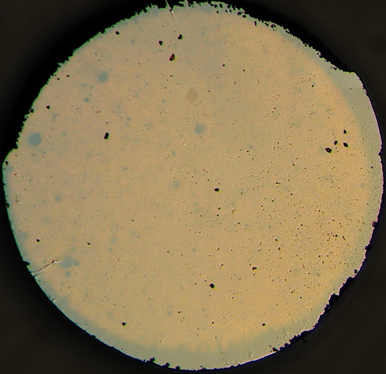
DECEMBER 15, 2021
Thermometer is a simple tool to measure temperature. You may image a glass-walled capillary tube, filled with a column of mercury, whose height will calibrate the room temperature. In such mercury-in-glass thermometer temperature is measured by the thermal expansion of liquid mercury. In a scientist's lab, temperature needs to be measured accurately and thermometer can be made from a variety of materials like ethanol, metal (called thermal couple), or even light radiation.
How do scientists measure pressure, a quantity your body will physically feel at the mountain summit or diving deep in the sea? Pressure is the force per unit area. Measuring air pressure is straightforward. How about the pressure inside a solid? “Think about a chunk a solid inside a big press. The force on the sample surface is difficult to obtain because the sample shape is changing all the time,” said Qingyang Hu from the Center for High Pressure Science and Technology Advanced Research.
Physicists design a barometer for solid by measuring two obtainable variables: density and compressibility. Density is easy to understand because we know applying pressure usually make a substance denser. Compressibility is how much volume the substance will change upon applying a certain pressure. Many methods can be used to measure the compressibility of solids. A widely used method is to measure the sonic wave velocity travelling through the solid, as sonic wave compresses solid as it propagates. Similar to the mercury-in-glass thermometer, a barometer can be made if we have found the suitable standard substance.
Such standard should have a few unique features. First of all, it won’t collapse under pressure, at least up to the pressure we are interested. Secondly, its compressibility can be easily calculated. Both conditions are non-trivial. A collaborative group led by Ho-kwang Mao, Qingyang Hu from the Center for High Pressure Science and Technology Advanced Research and Baosheng Li from Stony Brook University, NY coined a baromter based on diamond. “The 1954 Nobel Physics Prize winner, Max Born, proposed a theory to resolve the compressibility of diamond from the Raman frequency and diamond is probably among the very few materials to have such physical relation. Our work proved that this theory is working at very high pressure, like million times of atmosphere. Measuring Raman spectra is much easier than chasing a sonic wave.” Said Ho-kwang Mao. The theoretical work found Born’s classic theorem of diamond is valid at least up to 1 terapascal, which is ten million atmospheres. They parameterized a function of Raman frequency to the pressure, making diamond a pressure senser. The theoretical work was published by the journal Matter and Radiation at Extreme.
They then verified the theory by measuring the density and sonic wave velocity of diamond in experiment. “This is a very challenging experiment because diamond is very hard and incompressible. It is previously impossible to perform such experiment because sound travels extremely fast in diamond. Therefore, we developed dedicated system to capture such tiny signal,”said Baosheng Li from SUNY Brook University. They also polished diamond sample into a pancake-like shape to ensure no pores or voids on the sample surface. Through these improvements, their work extended the research forefront of diamond's sound velocity from 1,400 to l20,000 atmosphere pressures. The pressure obtained from their experimental results perfectly match with Born's theory, reaching consistency with their theoretical works. The experiment results were published by the recent issue of Proceeding of the National Science Academy of Science, U.S.A.
"The community of high-pressure sciences urgently need a barometer that robustly reads out pressure. Simply load a diamond chip into the sample chamber and it will show the pressure information for your experiment.” added Qingyang. The work is also collaborated with Xiang Gao, Lei Su and Yan Bi from the Center for High Pressure Science and Technology Advanced Research and supported by National Natural Science Foundation of China and the Tencent Xplore Prize.

Caption: A diamond "pancake" ready for high-pressure experiment.
Refs:
Qingyang Hu* and Ho-kwang Mao, Born's valence force-field model for diamond at terapascals: Validity and implications for the primary pressure scale. Matter Radiation at Extremes. 6, 068403 (2021).
Qingyang Hu, Baosheng Li*, Xiang Gao, Lei Su, Yan Bi and Ho-kwang Mao*, Ultrasound elasticity of diamond at gigapascal pressures, Proceedings of the National Science Academy, U.S.A. DOI: 10.1073/pnas.2118490118. (2021).
建立一套精确、稳定的压标是高压科学的根基。动高压研究获得的压标已经沿用了半个世纪,虽然以动高压实验为基础的压标在几十个GPa的压力段十分精确,但为获得更高的动高压无法避免会产生更多热量,导致等温压缩至几百个GPa的压力标定仍不精确,因此压力误差随着压力增大显著提升,影响了高压物理、地球科学等众多学科领域的压力测量精度。北京高压科学研究中心的毛河光院士、胡清扬研究员使用第一性原理计算,验证了马克思波尔在1932提出的金刚石结构共价理论依然适用于几百个GPa的超高压,能通过金刚石的拉曼光谱实时获得弹性常数,进而推导出压力。理论研究结果为建立一套超高压压标提供理论基础,成果以“Born’s valence force-field model for diamond at terapascals: Validity and implications for the primary pressure scale”为题发表在《极端条件下的物质与辐射》上;他们与美国Stony Brook的李宝生教授合作,结合超声波干涉测量和大压机,将金刚石弹性的研究上限从千巴压力扩展到几千兆帕,并获得了金刚石的原位压标,在测试范围内与前文提到的理论推演的一致。实验结果以“Ultrasound elasticity of diamond at gigapascal pressures”为题发表在《美国科学院院刊》上。两项研究从理论和实验角度同时指出金刚石具有成为绝对压标的独特潜力,并可能成为高压科学的基石。该研究得到NSAF联合基金,中物院创新发展基金以及腾讯基金会的大力支持。